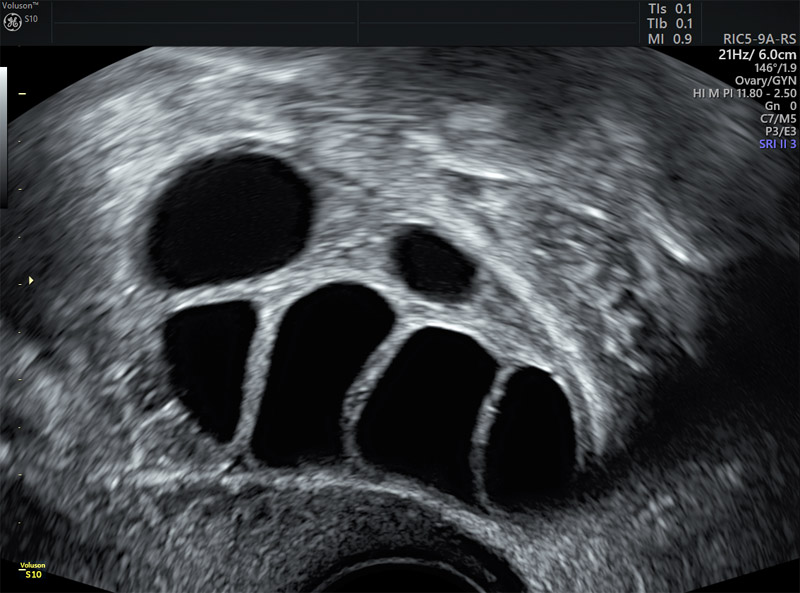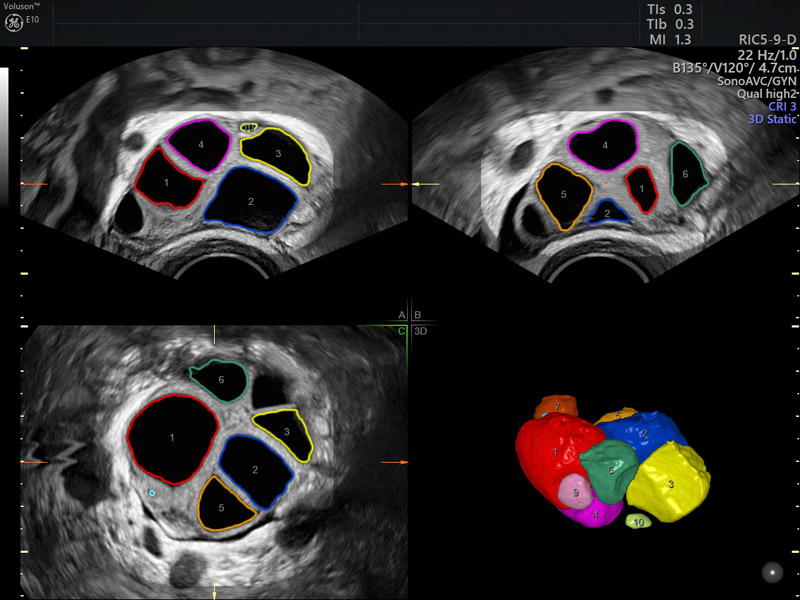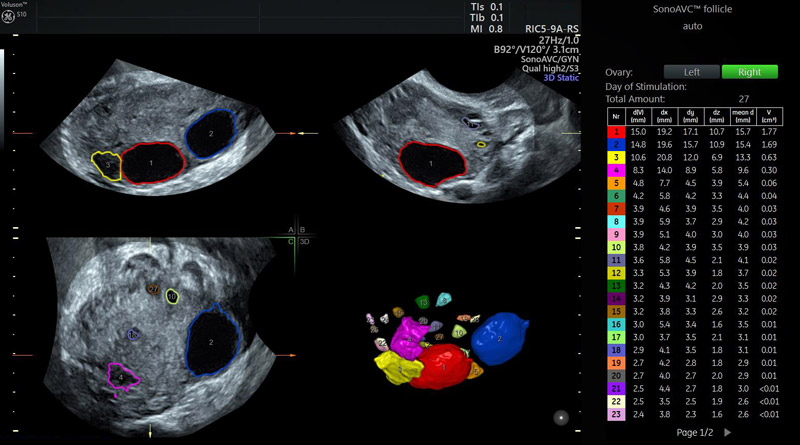
How Ultrasound Improves Accuracy and Efficiency when Measuring Follicles for IVF
3D Ultrasound When It Really Counts

See how automating follicular assessment using 3D ultrasound is helping IVF patients dictate timing for fewer missed opportunities.

When you’re assessing her follicles for IVF—size matters and counting is crucial.You need the right numbers to find the right eggs for the best outcome.With so much at stake, does 2D ultrasound really measure up?
It’s simple math: the higher number of quality eggs a woman has, the greater her chances of having a baby. That’s why accurate follicular measurements during stimulation are critical in the IVF process. These calculations dictate timing—and missed follicles could mean missed opportunities.

“We need to have precise measurements, so we can interrupt stimulation at the right time. More important than the number of follicles, is the size. If a follicle is smaller than what you measured, you cannot use the egg to be fertilized. On the other hand, if it becomes too big, the egg might not be suitable for fertilization,” said Dr. Angela Palumbo of Centro de Fecundación In Vitro FIVAP in Tenerife, Spain.
To reduce potential errors, Palumbo relies on Voluson’s™ SonoAVCfollicle—an ultrasound tool that automatically measures follicles using 3D technology. Simply select an ovary and scan. In most cases, there’s no need for a manual count.
“With the touch of a button, I have all these measurements. Not having to measure each follicle has been a huge advantage for me,” Palumbo said.
“Manual measurements are very challenging, especially when multiple follicles are present. People get lost and have to start over from the beginning. It’s possible to miss a follicle, or measure the same one twice.”
SonoAVCfollicle is also designed to overcome other challenges, including inter-observer and intra-observer variability. In fact, 3D ultrasound has been shown to increase the reproducibility of measurement and evaluation.1,2 It also allows for the standardization of ultrasound exams through the automated multi-planar approach.3,4

Palumbo discovered another significant advantage with Voluson. The 3D technology has allowed her to use follicular volumes to predict the number of mature oocytes, rather than just making judgements based on diameter. Through years of research, Palumbo has been able to demonstrate that follicles with a volume bigger than .7 on the day of ovulation induction usually contain mature eggs.5,6
“With volumes we have a more precise picture of the entire ovary and we can optimize the number of mature eggs we get,” Palumbo said. “For example, in poor responders we know every follicle is important. If we looked at manual measurements, we would continue the stimulation—but many times, SonoAVCfollicle tells us to stop—the patient is ready.”

The ability to automate follicular assessment using ultrasound is also more efficient. The patient can be scanned with the transvaginal probe and go. She doesn’t need to endure a lengthy, and often uncomfortable, ultrasound exam. That matters to IVF patients like Jessica*, who required numerous trips to the office for monitoring.
“I was going in there every other day to see how my follicles were growing. I remember feeling really heavy and bloated. They would do a scan and then freeze the image, circle the follicle and measure it. And then they’d do it again. You do that 15 times and you start to feel like a dog who is going to have a litter. It just hurts,” she said.
Not only does 3D imaging provide a better patient experience, Palumbo believes using SonoAVCfollicle ultimately helps increase a woman’s chances of getting pregnant.

Savc single
“It’s a better way. We get more good follicles with mature eggs—which is what we want. That improves the IVF result.”
*Name of patient has been changed to protect her identity
-
Learn more about the benefit of Voluson™ SonoAVC™ technologies through case studies presented by Dr. Palumbo.
-
A Voluson 3D transvaginal ultrasound offers real advantages when screening for infertility symptoms. Learn how Dr. Hanson manages fertility testing and sign up to Stay Informed. Understanding infertility symptoms before the disease.
-
Using pelvic ultrasound to screen the female reproductive organs for structural causes of infertility is one of the best first steps when beginning an infertility assessment. Voluson 2D and 3D ultrasound is used to assess uterine shape, size and provides views that allow you to assess for normal anatomy or pathology. Learn more about how Voluson can help enhance communication with your patients. What is infertility? What patients want to know.
-
Learn more about how Voluson ultrasound systems continually push the boundaries of Reproductive Medicine imaging to give you simple, yet innovative tools to help you and your patients achieve their dream of a successful pregnancy.
-
An estimated one in four couples worldwide are affected by infertility. While infertility is rarely considered a national health priority by governments, its impact on the lives of individuals, couples and their families who experience problems having children are enormous. The development of Assisted Reproductive Technologies (ART) is gradually transforming the range of options available to couples and individuals, bringing hope to millions. The WHO gives insights with this IFFS Surveillance 2016 report about the opportunities and challenges facing expansion of ART services.
-
The history of IVF dates back further than the birth of the first "test tube baby" in 1978. Learn how this technology developed, and where it's going next.
-
Fertility can be a concern for people in their reproductive years, as these patients may have questions about diagnoses, treatments and causes of infertility. Learn about some of the causes, diagnostic test and treatment options available to patients. What to Know About The Causes of Infertility, Evaluation and Treatment.
-
There are a variety of different types of fertility treatments patients can try before IVF. Learn how doctors can discuss these options with their patients.
-
Reproductive endocrinologists can reduce the IVF cost burden by proactively explaining the purpose of each step in the process to help educate patients.
-
Reproductive endocrinologists can reduce the IVF cost burden by proactively explaining the purpose of each step in the process to help educate patients.
-
Reproductive aging in women has an ovarian and uterine component. Doctors should use ultrasound and blood tests to assess ovarian reserve and oocyte health.
-
3D ultrasound enables physicians to build strong relationships with their patients by anticipating possible congenital uterine anomalies in women with infertility or repeat adverse pregnancy outcomes. What You Should Know About Congenital Uterine Anomalies.
1.. Deutch TD, Abuhamad AZ, Matson DO, Bocca S, Stadtmaucer LA, OEhniger SC. Clinical evaluation of a novel automated follicular assessment software program in women undergoing controlled ovarian hyperstimulation for in vitro fertilization using three dimensional sonography. Fertility and Sterility 2007; 88:S80
2. Deutch TD, Abuhamad AZ, Matson DO, Bocca S, Stadtmaucer LA, OEhniger SC. Automated calculation of ovarian follicular diameters using three dimensional sonography in women undergoing in vitro fertilization (IVF): a prospective evaluation of a novel software. Fertility and Sterility 2007; 88:S80
3. Benacerraf BR, Shipp TD, Bromley B. Improving the efficiency of gynecologic sonography with 3-dimensional volumes: a pilot study. J Ultrasound Med. 2006;25:165-71.
4. Abuhamad A. Automated multiplanar imaging: a novel approach to ultrasonography. J Ultrasound 2004;23:573-576
5. Rodríguez-Fuentes A, et al. Prospective evaluation of automated follicle monitoring in 58 in vitro fertilization cycles: follicular volume as a new indicator of oocyte maturity. Fertility and Sterility 2010;93(2):616-20. doi: 10.1016/j.fertnstert.2009.02.058. Epub 2009 Apr 18.
6. Hernández J, Rodríguez-Fuentes A, Puopolo M, Palumbo A. Follicular Volume Predicts Oocyte Maturity: A Prospective Cohort Study Using Three-Dimensional Ultrasound and SonoAVC. Reproductive Science 2016;23(12):1639-1643. Epub 2016 Sep 29.


